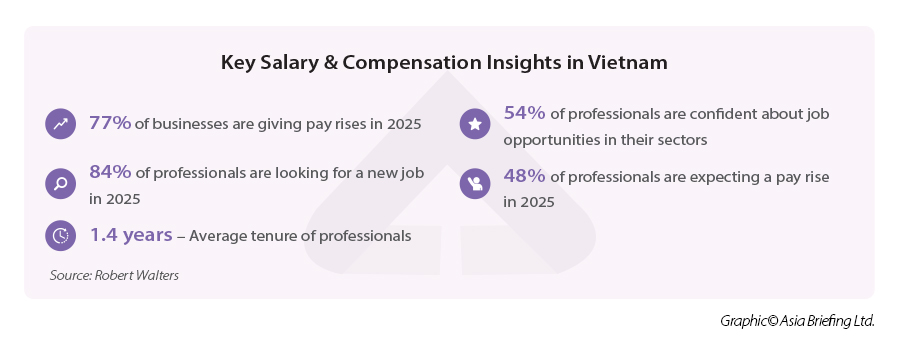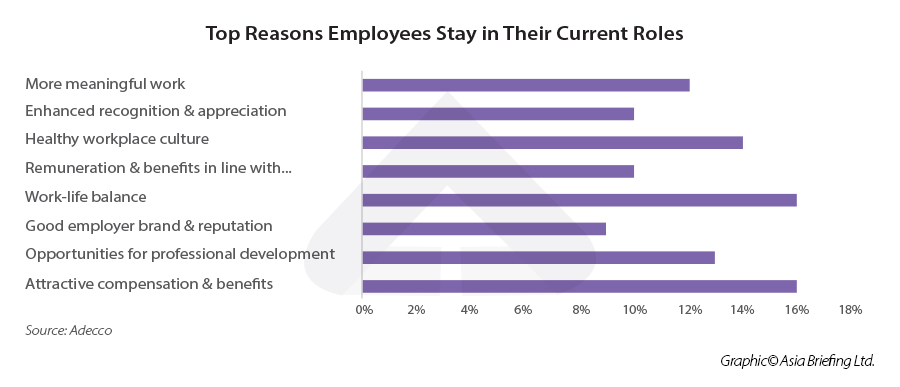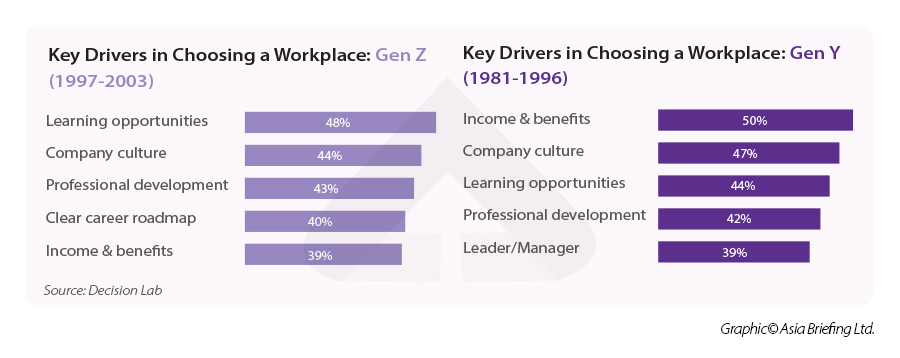Vietnam’s labor market is undergoing a profound transformation amid rapid economic growth and shifting workforce dynamics. With a new focus on flexible work environments and meaningful roles, organizations must adapt HR and payroll strategies to meet evolving workforce demands.
FIND BUSINESS SUPPORT
Vietnam’s dynamic economic growth and attractive investment policies for prioritized sectors have been notable perks for businesses and investors seeking opportunities in the country.
However, with only 28.8 percent of workers having formal training, significant labor quality gaps escalate competition for high-skilled personnel, especially in green and digital sectors. This shift, along with the projected changes in Vietnam’s workforce, has influenced how businesses recruit and retain talent in the country.
Simultaneously, according to a survey by Talentnet, Generation Z (Gen Z), which is projected to make up 34 percent of Vietnam’s workforce by 2030, will reshape the work environment with new perspectives and lifestyles. In addition to motivations stemming from market demands and governmental orientations, their preferences will infuse a breath of fresh air into the country’s office life.
See also: Vietnam Wages in 2025: Overview, Trends and Implications for Investors

What do Vietnam’s talents seek?
Hybrid work structures on the rise
The habit of remote work, which became customary during COVID lockdowns, has evolved into a preference for hybrid work models among many employees. Research co-published by The Sentry and Decision Lab in September 2024 revealed that 62 percent of survey respondents preferred a mix of office and remote work, compared to 15 percent who preferred working only in the office and 9 percent who preferred a fully remote role.
The trend indicates a growing desire among employees for flexible working arrangements and better work-life balance. Companies have widely acknowledged this shift. Sectors such as IT, education, and finance are implementing hybrid models to attract and retain top talent.
Open to new opportunities
FIND BUSINESS SUPPORT

A study conducted earlier this year by researchers at Adecco Vietnam found that 65 percent of professionals surveyed reported salary increases of less than 10 percent in 2024. In contrast, 15 percent received raises greater than 20 percent this year. Expectations for 2025 are even more optimistic, with 37 percent predicting raises over 20 percent.
The disparity between expectations and challenging realities has prompted many to explore new opportunities, with 72 percent of respondents open to a career change in 2025, rising from 69 percent in 2024 and 37 percent in 2023. This trend emphasizes a dynamic talent market, presenting both challenges and opportunities for employers.
While most employees decide to remain with their current companies for various factors, including earnings, career development opportunities, company culture, and work-life balance, salary stands out as the primary motivator when seeking new opportunities.

AI adoption by mid-level managers
As reported by Adecco, AI adoption in Vietnam is primarily centered on basic automation tasks like simple coding, customer service, data analysis, and content creation. Its application spans various management levels.
Mid-level managers are increasingly utilizing AI for analysis and planning, whereas senior leaders are employing it as a sophisticated tool for forecasting, aiding decision-making, and optimizing operations. Adecco’s survey reveals that 65 percent of participants recognize AI’s efficiency, 54 percent acknowledge its contribution to strategic thinking, and 35 percent emphasize the necessity for upskilling to enhance its impact.
Purposeful work prevails for Gen Z
FIND BUSINESS SUPPORT

Gen Z is transforming job roles and structures with their focus on meaningful work. According to Decision Lab’s survey, this generation places a high value on purpose, with 37 percent indicating it as their key factor for job satisfaction. Notably, 26 percent of Gen Z workers feel uneasy about monotonous tasks, while 32 percent fear they may not reach their full potential.
In response, innovative companies are adopting purpose-driven job designs that align individual tasks with broader organizational goals. For instance, objectives and key results (OKR) frameworks effectively link company missions to the contributions of individual team members. Ongoing “purpose alignment” conversations enhance traditional performance evaluations, ensuring a fit between employees’ personal values and corporate objectives.
This alignment fosters a more engaged and motivated Gen Z workforce, addressing their concerns about job satisfaction and personal development.

|
Top Recruitment and Retainment Strategies for the Vietnam Market |
||
|
Strategy area |
Key approaches |
Employer considerations |
|
Harmonized compensation, recognition, and work culture strategies |
– Align compensation and benefits with industry standards |
– Maintain engagement with employees to understand their needs |
|
Leverage AI recruitment |
– Use AI for job posting, sourcing & screening |
– Train staff on ethical AI use & bias mitigation |
|
Implementing flexible working models |
– Offer personalized hybrid models beyond fixed office days |
– Avoid one-size-fits-all return mandates |
|
Investing in upskilling and cross-training |
– Offer lateral moves and cross-functional opportunities |
– Link development programs to personal goals |
Technology application in HR and payroll management
Benefits of HR and payroll technologies
FIND BUSINESS SUPPORT

For multinational firms, adapting HR and payroll management to various markets poses a daunting challenge that typically demands labor-intensive operations and manual data entry, leading to significant risks of inaccuracies and human errors.
The emergence of new technologies has provided a much-needed solution to these concerns, enabling businesses to effectively implement recruitment and retention strategies and optimize their talent management.
Some of the most considerable merits of technology application in HR and payroll management include:
- Speeding up hiring processes: AI is transforming recruitment by optimizing operations, reducing costs, and speeding up hiring. Platforms like LinkedIn’s AI hiring assistant incorporate features to streamline the recruitment lifecycle, automating tasks like job postings, candidate sourcing, and preliminary screenings, thereby enhancing efficiency.
- Enhancing accuracy: Leveraging technology enhances accuracy by linking employee and timekeeping data directly to payroll software. This automation minimizes manual input, allowing employees to quickly and accurately generate salary slips based on pre-defined formulas.
- Reducing costs: Businesses nowadays can choose ready-made solutions or outsource through Software-as-a-Service (SaaS) instead of developing software in-house for their HR and payroll management. SaaS models are typically more cost-effective than traditional software licensing, as they save organizations the expense of developing, maintaining, and updating systems.
- Ensuring data security: Salary information, being sensitive and confidential, faces a higher risk of data breaches when locally stored. To enhance security, payroll systems should be on cloud-based HR management platforms, allowing access only through authorized accounts and ensuring that sensitive information remains protected for verified personnel.
- Securing payroll outsourcing: Technology enables centralized, cloud-based payroll systems that synchronize all salary data, enhancing security and reducing data fragmentation.
See also: Leveraging ERP for Operational Excellence in the Digital Age
Implementation of automated payroll systems
FIND BUSINESS SUPPORT

When it comes to payroll processing, most HR departments encounter the time-consuming and burdensome nature of various management tasks, such as calculating employee wages, withholding the correct amount of taxes, generating payslips, and filing tax returns. This situation has led to the growing popularity of automated software that manages payroll for businesses, serving as an effective tool to minimize human error, enhance operational efficiency, and standardize compliance.
While there is no single approach to effectively implementing payroll automation, companies should consider the following steps:
Step 1: Assess current payroll processes
- Map out your existing payroll workflow.
- Identify repetitive, time-consuming, or error-prone tasks (e.g, manual overtime calculations, Excel data entry).
- Define clear automation goals (e.g., improving accuracy, saving time, ensuring compliance).
Step 2: Centralize employee data
- Gather and verify all employee data (salaries, benefits, tax status, banking details).
- Store information in a single, secure location to ensure consistency and accessibility.
Step 3: Configure payroll automation systems
- Customize settings for pay frequency, classifications, and regional tax rules.
- Set up workflows for bonuses, deductions, and overtime.
- Enable self-service portals for employees to access payslips and update personal details.
Step 4: Integrate with other systems
- Connect payroll software with HR, accounting, and time-tracking tools.
- Eliminate data silos and ensure seamless information flow across departments.
Step 5: Test the system before full rollout
- Run simulations with a small group to validate calculations (wages, taxes, bonuses, reimbursements).
- Identify and resolve errors before full implementation.
Step 6: Implement in phases and scale gradually
- Start with a pilot group (one team or location).
- Monitor performance, gather feedback, and make adjustments.
- Expand automation company-wide once the system is optimized.
The above approach offers a framework for self-modifications to develop the most suitable practices for each company.
|
Top Payroll Software in Vietnam |
|||
|
Software (Provider) |
Key features |
Pros |
Cons |
|
AMIS Tiền Lương (MISA AMIS) |
Automatic salary calculation; KPI-based payroll; insurance & tax integration; payroll reports; employee confirmation portal |
Easy to use; accurate; customizable; strong support; secure |
Complex setup for unique pay structures; annual subscription |
|
CorePayroll (CoreHRM) |
Weekly/monthly salary; tax compliance; employee self-service; leave & allowance tracking |
Good security; fast processing from Excel; supports allowances; basic reporting |
No timekeeping integration; limited feature depth |
|
FastWork Payroll (FastWork) |
KPI + timekeeping integration; detailed access control; 3P salary structure; customizable templates |
High security; strong ecosystem; user-level control; versatile exports |
High cost; lacks advanced HR analytics |
|
DigiiC&B (OOS Software) |
Full automation; multi-shift/location; KPI-linked; graphical payroll reports |
Integrates with time-attendance devices; flexible salary setups |
Cannot handle complex data sets |
|
Tanca (Tanca.io) |
Tiered salary levels; Excel-like formulas; mobile payslip; AI timekeeping |
Low cost; flexible; bilingual; strong timekeeping integration |
Occasional bugs; no automatic leave-time aggregation |
|
FTSHRM (FTS Vietnam) |
Shift-based salary; overtime rounding; HR record storage; detailed reports; asset & training management |
Full HR coverage; customizable; suitable for large firms |
High infrastructure cost; not good for SMEs |
|
Paradise HRM (Paradise) |
Free payroll tool; tracks tax, bonuses, leave |
Free; supports various pay types; insurance integration |
Less user-friendly; internet dependent |
|
Ecount ERP (Ecount Inc.) |
Cloud-based; payroll + timekeeping integration; bulk payslip email |
Intuitive UI; centralized data; email automation |
Limited customization; some manual work |
|
1Office (1Office) |
KPI sync; online salary approval; insurance & tax calculation; multidimensional reports |
Comprehensive reporting; scalable; automated payslip dispatch |
Requires onboarding time; best for large firms |
|
Base Payroll (Base.vn) |
Formula builder; HRM integration; pay cycle setup; version history; custom reports |
Fully automated; integrates with Base suite; tailored config |
No free trial; setup required |
Conclusion
The strategic approach to HR and payroll in Vietnam is evolving, with shifting priorities. As a diverse and dynamic workforce, especially driven by younger generations, companies must adapt to these changes to succeed in the evolving economy.
Although payroll automation simplifies management, businesses must consider factors when choosing the right solution. MNCs need software that handles global payroll complexities, stays updated with tax laws, and integrates smoothly with existing HR, finance, and in-house systems.
As businesses grow, their payroll solutions should provide scalability and support multiple currencies, jurisdictions, and employee types. It is essential to recognize that payroll operates under stringent deadlines, necessitating the assurance of timely responses when processed by the automated platforms.
See also: Vietnam Work Permit Regulations: New Rules from August 2025
About Us
Vietnam Briefing is one of five regional publications under the Asia Briefing brand. It is supported by Dezan Shira & Associates, a pan-Asia, multi-disciplinary professional services firm that assists foreign investors throughout Asia, including through offices in Hanoi, Ho Chi Minh City, and Da Nang in Vietnam. Dezan Shira & Associates also maintains offices or has alliance partners assisting foreign investors in China, Hong Kong SAR, Indonesia, Singapore, Malaysia, Mongolia, Dubai (UAE), Japan, South Korea, Nepal, The Philippines, Sri Lanka, Thailand, Italy, Germany, Bangladesh, Australia, United States, and United Kingdom and Ireland.
For a complimentary subscription to Vietnam Briefing’s content products, please click here. For support with establishing a business in Vietnam or for assistance in analyzing and entering markets, please contact the firm at vietnam@dezshira.com or visit us at www.dezshira.com
